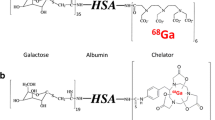Abstract
IDA derivatives of three substituted benzothiazol, and two substituted chlorophenyl and one substituted pyrazoline compounds have been labeled with 99mTc and screened with four rat models with hepatocellular dysfunction manifesting varying degrees of change of liver architecture and hepatocellular damage associated with an active parenchymal destruction, fatty metamorphosis and cirrhosis. Organ distribution studies at 1 h postinjection have been compared in normal and diseased animal models for each agent labeled with 99mTc and with 99mTc-Disofenin (Disida) and Lidofenin (Hida) and 131I-Rose Bengal. From the data obtained with the six new IDA derivatives, the distribution kinetics of 99mTc-Arclophenin, (N-N′-2-benzoyl-4-chlorophenyl)carbamoylmethyl) imino diacetic acid (Phenida), are closely comparable to 99mTc-Disofenin in all animal models.
Crossover patient studies (n=14) for clinical evaluation of 99mTc-Arclophenin vs 99mTc-Disofenin indicate the close similarity of the 2 agents with regard to blood pool retention, gross liver/heart ratios and liver washout, suggesting Arclofenin as a suitable agent for hepatobiliary function studies. The impaired hepatocellular animal models presented should serve for fast screening of hepatobiliary agents and enable comparison of a series of closely related compounds.
Similar content being viewed by others
References
Biersack HJ (1981) Radiopharmacology of IDA-derivatives in experimental liver parenchymal damage as well as obstructed bile ducts. In: Cox PH (ed) Cholescintigraphy. Nijhoff, The Hague, pp 44–53
Chervu LR, Nunn AD, Loberg MD (1982) Radiopharmaceuticals for hepatobiliary imaging. Sem Nucl Med 12:5–17
Cox PH (1981) Cholescintigraphy. Nijhoff, The Hague
Ehrinpreis MN, Giambrone MA, Rojkind M (1980) Liver proline oxidase activity and collagen sysnthesis in rats with cirrhosis induced by carbon tetrachloride. Biochim Biophys Acta 629:184–193
Fueger GF (1981) The biokinetics of Tc-99m labeled hepatobiliary agents in humans. In: Cox PH (ed) Cholescintigraphy. Nijhoff, The Hague, pp 44–53
Hernandez M, Rosenthall L (1980) A crossover study comparing the kinetics of Tc-99m-labeled diethyl- and diisopropyl-IDA. Clin Nucl Med 5:352–358
Medline A, Schaffner F, Popper H (1970) Ultrastructural features in galactosamine induced hepatitis. Exp Mol Pathol 12:201–211
Walker RM, Racz WJ, McElligott TF (1980) Acetaminophen induced hepatotoxicity in mice. Lab Investigation 42:181–189
Weissman HS, Freeman LM (1984) The biliary tract. In: L.M. Freeman (ed) Freeman and Johnson's Clinical radionuclide imaging, Vol 2. Grune and Stratton, New York, pp 879–1049
Author information
Authors and Affiliations
Rights and permissions
About this article
Cite this article
Chervu, L.R., Joseph, J.A., Chun, S.B. et al. Evaluation of six new 99mTc-IDA agents for hepatobiliary imaging. Eur J Nucl Med 14, 441–445 (1988). https://doi.org/10.1007/BF00252386
Received:
Accepted:
Issue Date:
DOI: https://doi.org/10.1007/BF00252386



